Early Years
Now that the river has once again awoken from its winter slumber the familiar sight of Uncle Sam tour boats cruising through the 1000 Islands will be welcomed by both local residents and tourists alike. Each year Uncle Sam Boat Tours gives thousands of people the opportunity to share in the natural beauty of the islands and to create lasting memories of their visit to the area. The company also has a significant economic impact on the region through the employment of local residents and the dollars spent in the community by the tourists it attracts.
The Uncle Sam boat line has a rich history in the village of Alexandria Bay and the company's origins can be traced back to the late 1800's.
Most historians will agree that the first commercial tours through the islands were pioneered by Captain Elisha Washington Visger in the 1870s with his small steam powered boat, the "Cygnet". The Visger family capitalized on the growing popularity of the region and built a thriving business serving the tourists with a fleet of steam ships that included the "Castanet" and the "Captain Visger".
Captain Visger, however, wasn't the only person in Alexandria Bay who recognized the potential of the burgeoning tourist business. A young man by the name of Clarence Stewart Thomson, better known simply as "Cap" (short for “Captain”), began a boat livery service to cater to the needs of both the tourists and local islanders. His business began with several St. Lawrence skiffs which were rowed to the desired destinations by well-muscled oarsmen and guides.
When the gasoline-powered marine engine was introduced early in the twentieth century it didn't take "Cap" Thomson long to embrace this new technology and he had soon built up a sizable fleet of motorboats to serve his growing clientele.
He named most of his boats either "Overland", which had dark mahogany hulls, or "Niagara", which were painted white. Two exceptions were the "New Niagara" which was the newest and largest tour boat of the group, and another runabout named “Brownie”. At one point in time Captain Thomson's boats, with their modern Redwing inboard engines, were among the speediest craft on the river. In 1924 Clarence incorporated his business and it became officially known as "Capt. C.S. Thomson's Motor Boat Tours, Inc.".
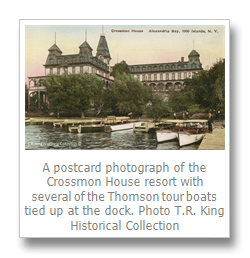
Around the same time Captain Thomson and William E. McDonell purchased the Crossmon House, a grand resort hotel located on the shore of the St. Lawrence River in Alexandria Bay. This new business venture was also incorporated in 1924 and Captain Thomson held a fifty percent ownership stake. This strategic acquisition not only gave the two gentlemen a foothold in the rapidly growing tourist hospitality market, it also ensured that "Cap" maintained a well-located base of operations for his tour boat business.
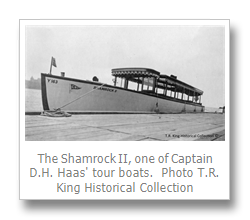
The introduction of the smaller and faster gasoline powered tour boats quickly lead to the demise of the steam powered vessels. It also meant that more men could afford to buy this type of craft and, before long, there was a very large and competitive tour boat industry operating out of Alexandria Bay. One of the earliest operators was Captain D. H. Haas who owned "Haas' MotorBoat Tours, Inc." and used the Cornwall's Dock for his boats. The Haas tour boats, which were all locally built, included the "Thousand Islander", "Shamrock", and "Shamrock II".
Another of the early tour boat entrepreneurs operating out of "The Bay" was Captain W.E. Adkins who ran the "Maxine" fleet of boats from the Thousand Island House Dock. In an advertising brochure from the time the flagship of Captain Adkins' fleet, the sixty-eight passenger "Maxine V", is described as, "the staunchest, most luxuriously appointed and roomiest motor boat in the Thousand Island district".
In 1927 Captain Haas and Captain Adkins decided to merge their operations and the new company that resulted was incorporated as "Combined 1000 Island Boat Tours, Inc.". The following year Captain Thomson realized that it was probably in his best interest, from a business perspective, to join the new boat line company, and he did so. A fourth boat line, "The Sis Thousand Island Boat Tours, Inc.", controlled by Claude R. Van Dresar and Harry Wagoner, also decided to join forces with the new company in 1928.
In 1930 a fifth company, "Ward Independent Boat Line", elected to join the "Combined" operation and they added their fleet of three “New Island Wanderers” to the mix. The Ward line was owned by Clifton Ward and his son Glen. At the time of the merger Clifton decided to retire and Glen assumed his responsibilities. The officers of the new company at this point in time were President, D.H. Haas; 1st Vice-President, C.S. Thomson; 2nd Vice-President, C.R. Van Dresar; 3rd Vice-President, Glen Ward; Secretary, Harry Wagoner; Treasurer, W.E. Adkins and the company’s stock was split evenly among the six men. Following the latest amalgamation the Combined Boat Tours had a fleet of twenty-one boats operating from several prime locations in Alexandria Bay.
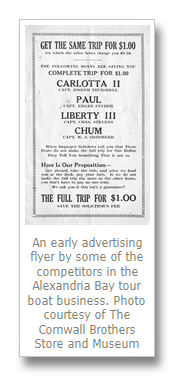
Even after the merger of the five boat lines into the "Combined Boat Tours" company there were still several competing tour operators in Alexandria Bay. Among them were the "Paul Boat Line" operated by Captain Edgar Snyder and the newly created "Ward's Independent Boat Line" whose principals were Earl and Carl Ward. Several independent operators, such as Captain Joseph Truesdell with his boat "Carlotta II" and Captain W.J. Shepherd and the "Chum" were also battling to get their own piece of the tourist business pie.
Along with the conventional wooden tour boats the "Combined" boat line also had a couple of beautiful wooden speed boats in the fleet. Harry Wagoner of the "Sis" boat line was a part owner of the "Wagoner and Powers Speed Line, Inc" which ran the "RIOT" Chris-Craft speed boat from the Upper James Street dock and it too was merged into the new company. Advertised as being able to skim over the waves at 50 miles per hour, the "RIOT" added an extra offering for the thrill seekers among the tourists. It wasn't too long before the "RIOT II" and the "RIOT III" were also racing around the river giving their passengers an exciting ride.
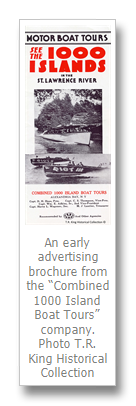
In 1950 Captain Thomson purchased the outstanding shares of the Crossmon House from the McDonell estate after William passed away and established a partnership in the business with his son, A. Graham Thomson. As a result of this transaction the Thomson family now had complete ownership of the resort. A few years later the family also purchased the Pine Tree Point estate with plans to build another waterfront resort on the property. The family's accommodation businesses were run under the corporate umbrella known as "Thomson Resorts".
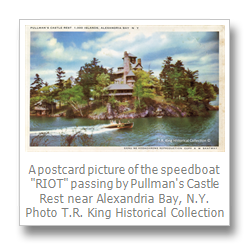
Also in 1950, the “Combined 1000 Island Boat Tours, Inc.” purchased the Peacock Yacht House from the Thousand Islands Club to serve as a maintenance and storage facility for the large fleet of wooden tour boats that the company was running. Tragically, the yacht house burned to the ground in 1992 and the old “Uncle Sam II”, which was being stored in the building at the time, was destroyed. (See Rick Tague's article on the Peacock Yacht House from March 2009 issue of T.I. Life)
Of the twenty-one boats that were operated by the "Combined" boat line only one was originally named "Uncle Sam". It was built in 1926 by Captain Van Dresar and proved to be very popular with the tourists. In 1930, the "Maxine II", one of W.E. Adkins' boats, was renamed "Uncle Sam II". It got to the point that the "Uncle Sam" boats were so popular that the passengers would wait for one of them and the other boats would have to run their tours at less than full capacity. In 1952 "Cap" Thomson, who was now President of the boat line, decided to change the name of the company to "Uncle Sam Boat Tours" and formed a new corporation under that name. All of the boats in the fleet were renamed as "Uncle Sam". The "Maxine III" became "Uncle Sam Jr.", the "Capt. Adkins" became "Uncle Sam IV", the “New Island Wanderer” became “Uncle Sam V” and so on.
The rebranding of the operation to the "Uncle Sam" moniker proved to be a wise decision as it gave the business a more unique identity and was very recognizable to the tourist market.
In 1955 a large consortium of Alexandria Bay businessmen formed a new boat line which was named "Pilgrim Boat Tours", presumably hoping to cash in on the patriotic theme that "Uncle Sam" had established. The beautiful old varnished Hutchinson launch "Pilgrim" that was built in 1923 became part of the fleet. The boats that were owned by Earl and Carl Ward, "Captain Cliff" and "Commander", became "Pilgrim II" and "Pilgrim III" respectively, while the old "Sis V" became "Pilgrim IV". In 1958 the brand new sixty-four foot long "Pilgrim V" was launched. With an extraordinarily large beam of over seventeen feet, the new "Pilgrim" flagship had a passenger capacity of 144. The new boat line even had their own speedboat, the "Pilgrim Jr.", to compete with the "RIOT" boats for the thrill seekers.
As the year 1960 approached "Cap" and Graham Thomson were forced to take a hard look at the business. Their fleet of "Uncle Sam" tour boats was aging and the new, larger "Pilgrim V" only reinforced the fact that the competition was making inroads into the market. Something definitely needed to be done to re-establish "Uncle Sam Boat Tours" as the premier boat line in Alexandria Bay.
Next month - Part 2 - Uncle Sam Boat Tours Reinvents Itself
|
Addendum
While doing research for this article I made use of many different resource materials, such as the NYS Historic Newspapers of Jefferson County, a searchable database of old newspapers (http://nyshistoricnewspapers.org/titles/places/new_york/jefferson/) and several pieces of tour boat related memorabilia from my personal collection. I also made extensive use of Bowling Green State University's Historical Collections of the Great Lakes database.
As an example, while searching the historic newspapers I came across an article from the June 24, 1925 edition of Ogdensburg's "The Republican Journal" about an explosion and fire that destroyed the Haas' boat lines tour boat, "Thousand Islander", at M.J. King's dock in Ivy Lea. The "Thousand Islander" pictured below (Figure 15) was built in 1926, so it was obviously a replacement for her namesake that was destroyed the previous year.
|
|
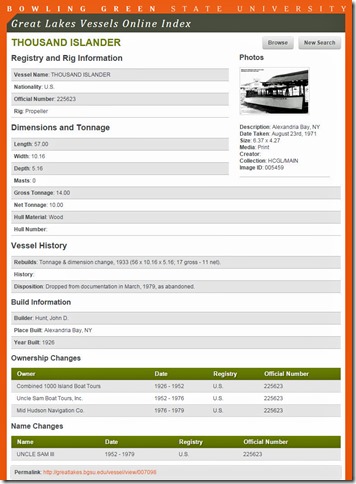 |
The Great Lakes Vessel Online Index entry for the tour boat "Thousand Islander". Used with the permission of the Historical Collections of the Great Lakes, Bowling Green State University. |
|
Acknowledgements
I would like to thank the following individuals and organizations for the assistance that they offered during the preparation of this article:
- Ron Thomson of Uncle Sam Boat Tours who provided a great deal of valuable historical information regarding the Thomson family and the Uncle Sam boat line. (http://usboattours.com/ )
- The Cornwall Brothers Store and Museum for allowing me access to their archival material related to the history of the local tour boat industry. (http://alexandriahistorical.com/)
- Robert Graham, Archivist for the Historical Collections of the Great Lakes at Bowling Green State University, for allowing me to use information from their on-line database in the article. (https://www.bgsu.edu/library/cac/collections/hcgl.html)
- Rick Roberts of Global Genealogy for assisting in gathering genealogical information for the article. (http://globalgenealogy.com/)
|
By Tom King
Tom King and his wife Marion have lived in Milton, Ontario for the past 30 years, where they both worked and raised their family of three children; Kris, Mike and Becca. Tom still has a strong attachment to the Thousand Islands, having grown up in Gananoque and being a “river rat” from a very early age. The family tries to return to the islands every summer and for the past several years have been renting a cottage on Sampson (a.k.a. Heritage) Island, just out from Gananoque.
Editor’s note: The King family is well known in the region as the “J.W. King Water Filtration Plant”, which stands on the shore of the St. Lawrence River in the Gananoque Marina Basin, was named after Tom’s father, in recognition of the contributions that he made to the upgrading of the Town’s water system, while acting as Chairman of the P.U.C. Click here to see all of Tom’s articles.